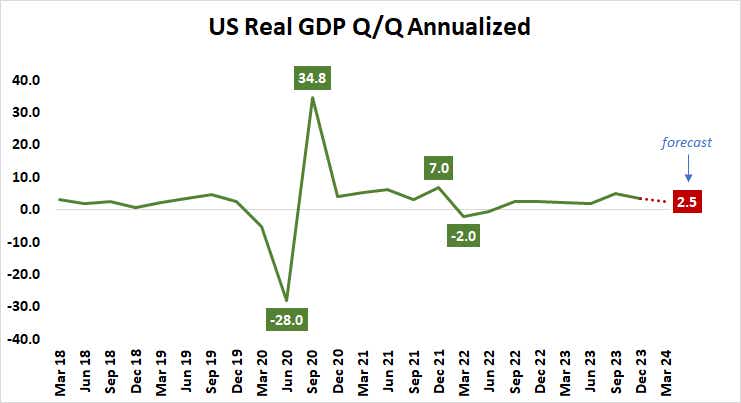Stocks May Fall If U.S. GDP Data Undercuts Fed Rate Cut Hopes

Stocks May Fall If U.S. GDP Data Undercuts Fed Rate Cut Hopes
By:Ilya Spivak
Stock markets are hoping that soft U.S. GDP data will help keep Fed interest rate cuts on the table for 2024. They may be disappointed.
- Wall Street is embracing a “bad is good” view of U.S. economic news.
- Q1 GDP data in focus as markets hope to keep rate cuts on the table.
- Annualized growth of 2.4% or higher may be trouble for risk appetite.
Financial markets seem to be embracing a “bad is good” interpretation of U.S. economic data once again.
The release of unexpectedly soft April purchasing managers index (PMI) data this week was a telling case in point: stocks surged, and the dollar tumbled as the numbers offered a bit of relief for traders worried about evaporating interest rate cut odds.
The baseline outlook priced into Fed Funds futures has undergone a dramatic transformation since the start of 2024. The year opened with markets envisioning six 25-basis-point (bps) rate cuts. That stood in stark contrast to official projections from the Federal Reserve, which penciled in three cuts or 75 bps in easing in late December.
Stock markets at the mercy of Fed rate cut bets
Since then, a steady stream of stronger-than-expected economic data—most potently, three back-to-back consumer price index (CPI) inflation readings registering hotter than analysts anticipated—has eaten away at the markets’ dovish stance. That proved to be digestible for markets while the priced-in view landed on the dovish side of the central bank.
And then, it wasn’t.

The turn of the switch came as the Fed issued an updated Summary of Economic Projections (SEP) on March 20, where it stuck to its guns on 75bps in rate cuts for 2024. The markets signaled their position just two days before that, pushing the priced-in view to 61 bps to mark the first time this year that the probability of a third cut fell below 50%.
As the dust settled and traders digested what transpired in the subsequent 24 hours, the bellwether S&P 500 stock index put in the top on a blistering five-month rise from late October 2023. It has since shed as much as 6.75% and is now trading down 4.2% after a tepid bounce this week.
U.S. GDP data: Wall Street praying for weakness?
The release of first-quarter U.S. gross domestic product (GDP) data is the next chapter in this story.
Experts expect GDP data to show that the annualized growth rate slowed to 2.5% from 3.4% in the three months to December. That would put growth on a hotter trajectory than the Fed’s 2.1% median forecast for the year, undermining the case for rate cuts.

Projections from the Fed’s Atlanta, New York, and St. Louis branches—the three most closely watched “nowcast” models trying to guesstimate GDP based on incoming economic data—range from 1.7% to 2.7%, offering little clarity. Analytics from Citigroup show that U.S. data outcomes have cooled relative to forecasts however, warning of a soft result.
The Fed penciled in a range of 2.0% to 2.4% as the “central tendency” for GDP growth this year. That it’s median was 2.1% implies a skew toward the lower end. On balance, this suggests that even a slightly weaker than expected outcome of 2.4% or anything higher might force a hawkish rethink. That would bode ill for stock markets.
Ilya Spivak, tastylive head of global macro, has 15 years of experience in trading strategy, and he specializes in identifying thematic moves in currencies, commodities, interest rates and equities. He hosts Macro Money and co-hosts Overtime, Monday-Thursday. @Ilyaspivak
For live daily programming, market news and commentary, visit tastylive or the YouTube channels tastylive (for options traders), and tastyliveTrending for stocks, futures, forex & macro.
Trade with a better broker, open a tastytrade account today. tastylive, Inc. and tastytrade, Inc. are separate but affiliated companies.
Options involve risk and are not suitable for all investors. Please read Characteristics and Risks of Standardized Options before deciding to invest in options.
tastylive content is created, produced, and provided solely by tastylive, Inc. (“tastylive”) and is for informational and educational purposes only. It is not, nor is it intended to be, trading or investment advice or a recommendation that any security, futures contract, digital asset, other product, transaction, or investment strategy is suitable for any person. Trading securities, futures products, and digital assets involve risk and may result in a loss greater than the original amount invested. tastylive, through its content, financial programming or otherwise, does not provide investment or financial advice or make investment recommendations. Investment information provided may not be appropriate for all investors and is provided without respect to individual investor financial sophistication, financial situation, investing time horizon or risk tolerance. tastylive is not in the business of transacting securities trades, nor does it direct client commodity accounts or give commodity trading advice tailored to any particular client’s situation or investment objectives. Supporting documentation for any claims (including claims made on behalf of options programs), comparisons, statistics, or other technical data, if applicable, will be supplied upon request. tastylive is not a licensed financial adviser, registered investment adviser, or a registered broker-dealer. Options, futures, and futures options are not suitable for all investors. Prior to trading securities, options, futures, or futures options, please read the applicable risk disclosures, including, but not limited to, the Characteristics and Risks of Standardized Options Disclosure and the Futures and Exchange-Traded Options Risk Disclosure found on tastytrade.com/disclosures.
tastytrade, Inc. ("tastytrade”) is a registered broker-dealer and member of FINRA, NFA, and SIPC. tastytrade was previously known as tastyworks, Inc. (“tastyworks”). tastytrade offers self-directed brokerage accounts to its customers. tastytrade does not give financial or trading advice, nor does it make investment recommendations. You alone are responsible for making your investment and trading decisions and for evaluating the merits and risks associated with the use of tastytrade’s systems, services or products. tastytrade is a wholly-owned subsidiary of tastylive, Inc.
tastytrade has entered into a Marketing Agreement with tastylive (“Marketing Agent”) whereby tastytrade pays compensation to Marketing Agent to recommend tastytrade’s brokerage services. The existence of this Marketing Agreement should not be deemed as an endorsement or recommendation of Marketing Agent by tastytrade. tastytrade and Marketing Agent are separate entities with their own products and services. tastylive is the parent company of tastytrade.
tastyfx, LLC (“tastyfx”) is a Commodity Futures Trading Commission (“CFTC”) registered Retail Foreign Exchange Dealer (RFED) and Introducing Broker (IB) and Forex Dealer Member (FDM) of the National Futures Association (“NFA”) (NFA ID 0509630). Leveraged trading in foreign currency or off-exchange products on margin carries significant risk and may not be suitable for all investors. We advise you to carefully consider whether trading is appropriate for you based on your personal circumstances as you may lose more than you invest.
tastycrypto is provided solely by tasty Software Solutions, LLC. tasty Software Solutions, LLC is a separate but affiliate company of tastylive, Inc. Neither tastylive nor any of its affiliates are responsible for the products or services provided by tasty Software Solutions, LLC. Cryptocurrency trading is not suitable for all investors due to the number of risks involved. The value of any cryptocurrency, including digital assets pegged to fiat currency, commodities, or any other asset, may go to zero.
© copyright 2013 - 2025 tastylive, Inc. All Rights Reserved. Applicable portions of the Terms of Use on tastylive.com apply. Reproduction, adaptation, distribution, public display, exhibition for profit, or storage in any electronic storage media in whole or in part is prohibited under penalty of law, provided that you may download tastylive’s podcasts as necessary to view for personal use. tastylive was previously known as tastytrade, Inc. tastylive is a trademark/servicemark owned by tastylive, Inc.